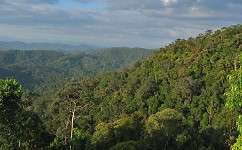Scientists reveal how soil and stone mixture determine Congo tree mix

Variations in the soil and stone beneath it are the biggest factor behind which trees grow where in the rainforests of the Congo basin, a new study has found.
The scientists looked at 31 species across more than 700,000km2 in Cameroon, the Central African Republic and the Republic of Congo, drawing on logging companies' records of which trees grow where. They also analysed information about the soil, climate and how much people had disturbed the forest in the past.
The results show that the geology beneath the forest had a much bigger impact on the mix of tree species growing there than the other variables. Much of the study area sits on top of a huge sandstone plateau, so it has sandy soil with few nutrients. The mix of trees growing in these areas is very different to that found over richer soil with more water and nutrients. Rainfall and human disturbance had some effect on the mix of trees, but a comparatively small one.
This sheds light on how trees end up distributed over large areas, and could help devise better ways to manage logging in tropical forests to prevent excessive deforestation and give tree cover enough time to grow back.
It also suggests that what controls forest composition is likely to depend closely on local conditions. Earlier studies in rainforests in other areas - in Panama, for example - have found that climate, particularly rainfall, is the biggest factor.
Things are different in the Congo basin, according to Dr Adeline Fayolle of the Université de Liège in Belgium, the paper's lead author. She says this is probably because the region's climate is much more consistent than that of many rainforests, with little variation from place to place. Other rainforests have more varied conditions, allowing moisture-loving species to dominate wet environments and others to take over dry ones.
'These are things that people working in forestry in the Congo have known for a long time - colonial botanists understood the importance of sandy soil,' she says. 'But this has not been communicated to a wider audience in a peer-reviewed journal before.'
The team is now working on a follow-up paper that it hopes will improve management of these forests. 'At the moment the rate at which the timber is harvested depends on calculations of the trees' growth rates,' Fayolle adds. 'But trees above sandstone will probably grow more slowly, so we might need to adapt the role to the local environment in terms of climate and soil fertility - in areas with slower growth, the timber stock will take longer to recover from logging.' The five-year project will look in more detail at how much more slowly trees grow on sandy soil due to limited water and nutrients.
Rather than analysing the mix of trees only in terms of the species present, the researchers also looked at which traits or ecological characteristics were in that mix. Doing so gave them an insight into exactly how environmental conditions come together to favour a particular mix of trees.
The sandy areas were dominated by evergreen trees with dense wood and slow growth; most were from species classified as non-pioneers or shade-tolerant. The non-sandy areas, on the other hand, tended to be deciduous with low-density wood and fast growth; many were pioneer trees noted for their ability to colonise disturbed land.
This confirms a prediction of ecological theory, known as 'environmental filtering' - that species found in similar areas tend to have similar life strategies, since those that can't cope with the conditions die off. It seems obvious, but it hadn't previously been demonstrated in a tropical forest on such a large scale.
The research appears in PLoS ONE. It was part of the Era Net Biodiversa CoForChange project, funded by France's National Research Agency and NERC. It drew on data provided by forestry companies, concentrating only on the trees that were reliably identified in their records.
More information: Fayolle A, Engelbrecht B, Freycon V, Mortier F, Swaine M, et al. (2012) Geological Substrates Shape Tree Species and Trait Distributions in African Moist Forests. PLoS ONE 7(8): e42381. doi:10.1371/journal.pone.0042381
Journal information: PLoS ONE
Provided by PlanetEarth Online
This story is republished courtesy of Planet Earth online, a free, companion website to the award-winning magazine Planet Earth published and funded by the Natural Environment Research Council (NERC).
















